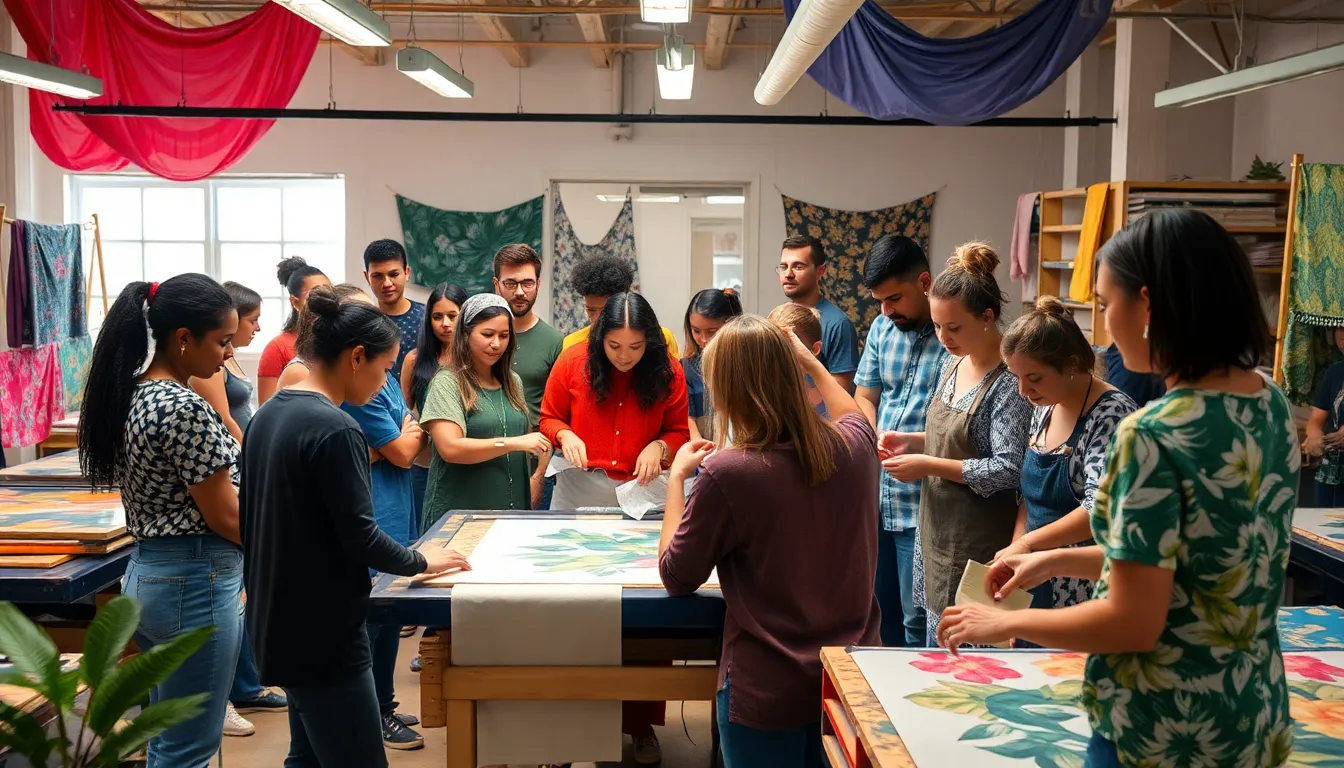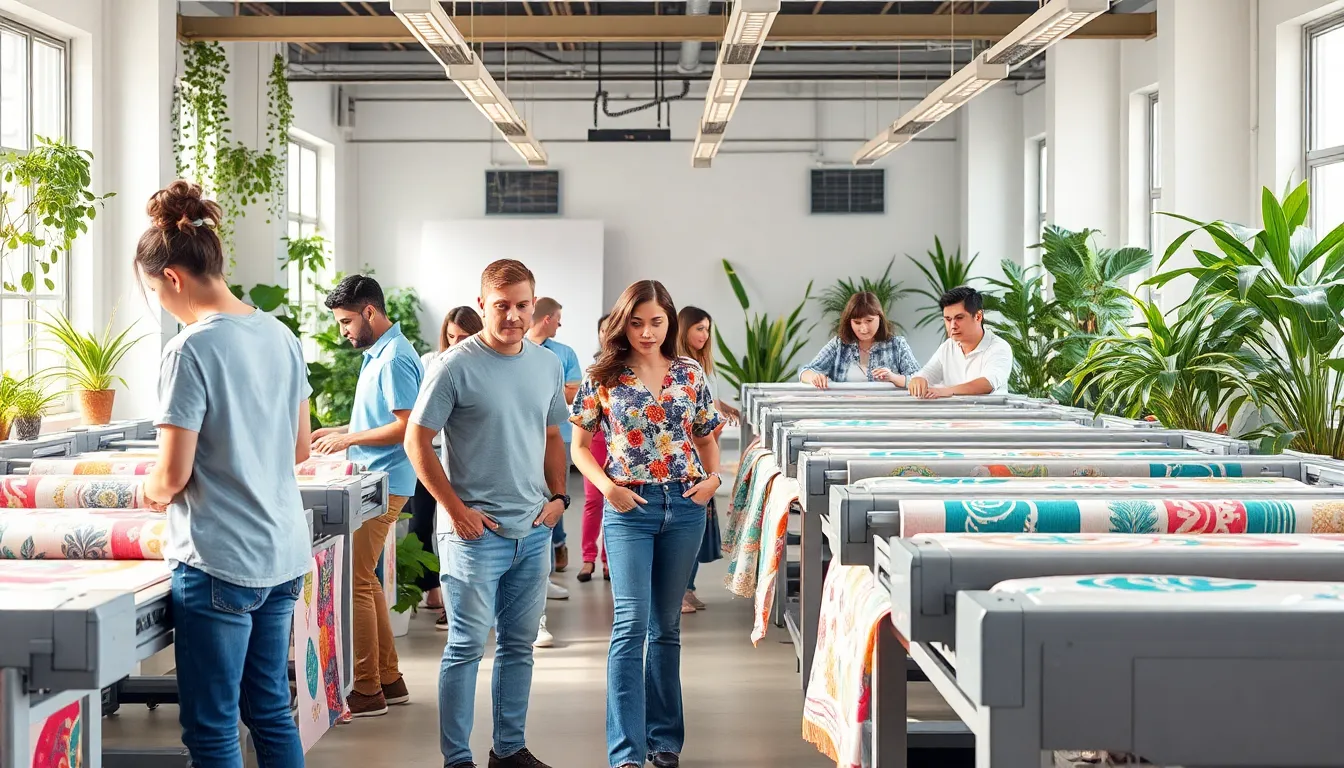In a world where fashion often clashes with eco-consciousness, sustainable fabric printing technology emerges as the superhero we didn’t know we needed. Picture this: vibrant colors, intricate designs, and zero guilt. It’s like having your cake and eating it too—only this cake helps save the planet!
Table of Contents
ToggleOverview of Sustainable Fabric Printing Technology
Sustainable fabric printing technology represents a significant advancement in eco-friendly fashion practices. This innovation reduces environmental impact while maintaining high-quality aesthetics. Processes like digital printing utilize water-based inks instead of toxic substances, minimizing soil and water contamination.
Various methods contribute to sustainability in fabric printing. Solutions such as dye-sublimation allow for vibrant image reproduction with minimal waste. Print-on-demand systems enable manufacturers to create products only as needed, effectively cutting down on overproduction and waste.
Ink formulations play a crucial role in sustainability. Many brands now opt for organic, non-toxic dyes that adhere to strict environmental standards. These inks not only reduce harmful emissions but also provide durability and brightness, ensuring products remain appealing over time.
Utilizing recycled materials in fabric production further enhances sustainability. The integration of recycled polyester or cotton helps conserve resources while lowering energy consumption during the printing process. Innovations like plant-based or biodegradable fabrics also contribute to eco-conscious sourcing.
Sustainable printing methods align with growing consumer demands for ethically produced goods. As awareness around environmental issues rises, more companies adopt these technologies, showcasing their commitment to sustainability. Retailers actively promote these initiatives to attract eco-savvy customers.
Cost-effectiveness is another key consideration. While initial investments in sustainable technology may be higher, long-term savings emerge through reduced water and energy usage. Moreover, many consumers express willingness to pay a premium for responsibly made products, further incentivizing businesses to embrace eco-friendly practices.
Benefits of Sustainable Fabric Printing


Sustainable fabric printing technology offers considerable advantages for both the environment and the economy. These benefits contribute to a more responsible approach to fashion.
Environmental Impact
Sustainable fabric printing significantly reduces environmental pollution. Traditional methods often rely on toxic chemicals that harm soil and water sources. Using water-based inks minimizes these risks and promotes cleaner production practices. Many sustainable options utilize recycled materials, reducing waste. Innovative techniques such as dye-sublimation further enhance resource efficiency, consuming less water and energy. Ultimately, eco-conscious printing supports biodiversity by decreasing the ecological footprint of the fashion industry.
Economic Advantages
Investing in sustainable fabric printing can yield long-term financial benefits. Companies experience reduced operational costs through lower resource consumption. As consumers seek ethically produced products, brands embracing these practices attract a growing market segment. Higher-priced sustainable items often lead to increased profit margins. Additionally, reduced waste and streamlined production processes lower overhead costs. Overall, sustainable practices enhance brand loyalty, positioning companies for success in a competitive market.
Types of Sustainable Fabric Printing Technologies
Sustainable fabric printing technologies encompass various methods that prioritize environmental responsibility while delivering quality results. Notable techniques like digital printing and eco-friendly inks contribute significantly to eco-conscious fashion.
Digital Printing
Digital printing revolutionizes the fabric printing industry through its advanced techniques. This method enables precise, high-resolution designs directly onto fabrics, eliminating the need for screens or plates. As a result, minimal waste occurs during production. Reduced water consumption further enhances sustainability, with some systems using less than 10% of the water required by traditional methods. Quick turnarounds facilitate on-demand printing, keeping inventory levels low and curbing overproduction. This approach aligns perfectly with modern consumer demands for unique, customized products.
Eco-Friendly Inks
Ingredients behind eco-friendly inks play a crucial role in sustainable printing. Many brands prioritize water-based or plant-based inks, which minimize hazardous chemical use. These formulations meet strict environmental standards while maintaining vibrant colors and durability. Such inks ensure safer production processes that are less harmful to workers and surrounding ecosystems. Brands utilizing organic dyes often create a lower environmental impact while appealing to ethically-minded consumers. Adopting eco-friendly inks illustrates a brand’s commitment to sustainability, further solidifying its position in the market.
Challenges in Implementing Sustainable Practices
Sustainable fabric printing technology presents several challenges that hinder its widespread adoption.
Cost Factors
High initial investments in sustainable practices limit many companies. Advancements in equipment and eco-friendly materials often come with higher price tags, impacting budgets. Although long-term savings may offset these costs, not all businesses can manage the upfront financial burden. Smaller companies face additional obstacles in accessing the necessary resources. Funding and financial incentives can influence decisions significantly.
Industry Adoption
Resistance from traditional manufacturers complicates industry-wide acceptance. Many companies prioritize short-term profits over long-term sustainability measures. Competitive pricing pressures lead to hesitation in adopting sustainable technologies. Education on the benefits of sustainable practices might facilitate better acceptance. Collaboration among stakeholders in the textile industry encourages knowledge sharing and collective advancement. Establishing a standard framework for sustainable practices boosts overall industry commitment.
Future Trends in Sustainable Fabric Printing Technology
Emerging technologies drive innovations in sustainable fabric printing. Increased use of bio-based inks, made from renewable resources, continues to gain traction. This shift encourages brands to eliminate fossil fuels and embrace eco-friendly options.
Consumer interest in personalization fuels advancements in print-on-demand services. Companies increasingly adopt these systems to reduce excess inventory and waste. Improved supply chain management ensures that resources are used efficiently, aligning production with consumer demand.
Integration of artificial intelligence enhances the design process. AI tools analyze trends and consumer preferences, helping designers create targeted collections. Brands leverage data-driven insights to minimize environmental impact while maximizing sales potential.
Recycling technologies for textile waste are evolving rapidly. Innovative processes convert discarded garments into usable fabric, further promoting circular economies. Manufacturers who embrace these techniques can significantly reduce their environmental footprint.
Collaboration among designers, manufacturers, and consumers is essential for driving sustainable practices. Industry stakeholders need to share knowledge and resources to create a unified approach. Strengthening partnerships fosters a culture of sustainability across the entire fashion ecosystem.
Transparency in sourcing and production processes becomes increasingly critical. More consumers demand information about the origins of their products and the methods used in production. Brands responding to this demand build trust and loyalty among eco-conscious consumers.
Regulatory pressures also influence the future of sustainable fabric printing. Governments implement stricter environmental regulations, encouraging the adoption of greener practices. Compliance with these regulations can enhance a brand’s market position, attracting eco-conscious shoppers.
Investment in research and development allows companies to discover new sustainable materials. These innovations may include plant-based fibers or biodegradable options. Staying ahead of trends ensures a brand’s competitiveness in the evolving market landscape.




